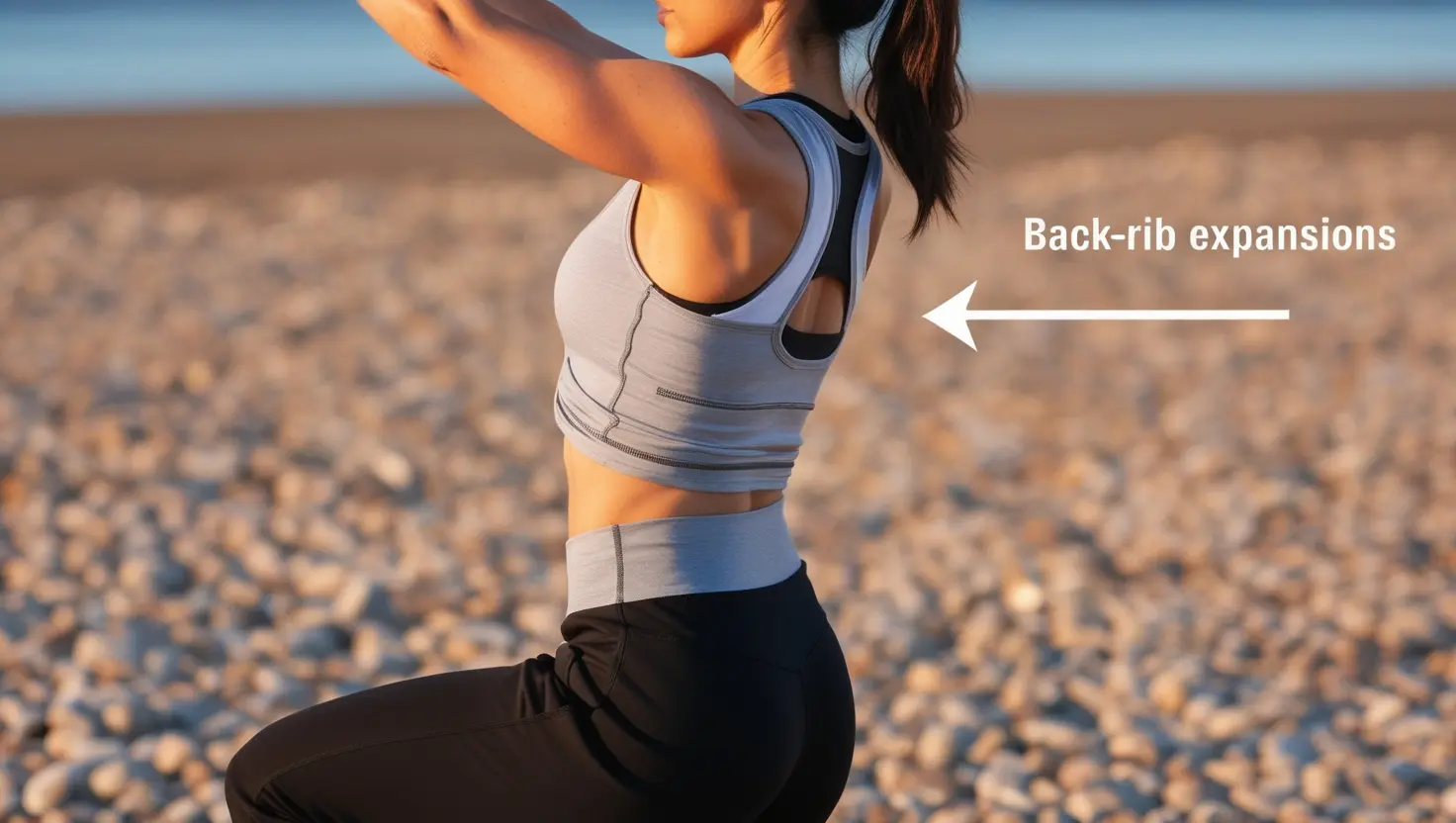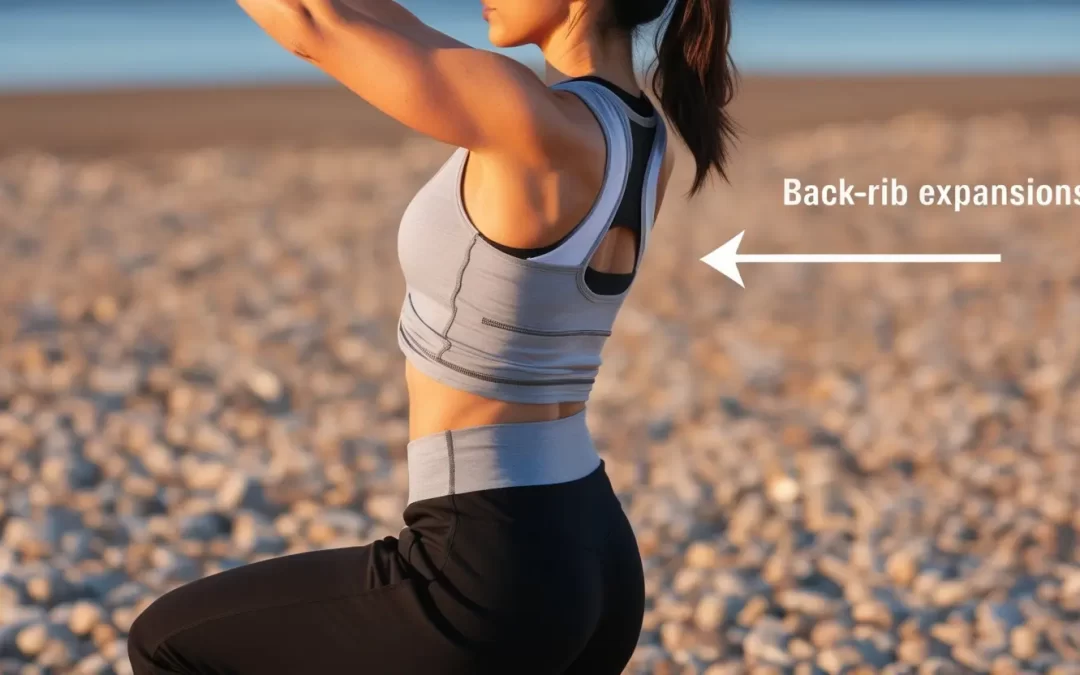360 Breathing and Bracing: Beyond Belly Breathing


Belly breathing is useful—but it isn’t the whole story. When breath is coached as “push the stomach out” and nothing more, we risk over-expanding the front, losing pressure at the back and sides, and leaving the lower spine less supported than it could be. The fuller, safer, and stronger approach is 360 breathing and bracing: expanding the breath forwards, sideways, and into the back ribs while maintaining calm, even support around the trunk.
🧠 Why belly-only cues can mislead
When the belly is the only focus, the lower ribs often lift and the front wall does most of the work. That can reduce back-rib motion, encourage rib flare, and limit the diaphragm’s ability to pressurise the whole cylinder of the torso. Over time, this can feel like a stiff upper back and a core that “leaks” pressure under load.
🧘 Where yoga helps—and how to use it
Yoga has always valued breath awareness. Many postures naturally invite back-rib mobility: gentle twists, side bends, prone backbends, and even child’s pose variations can all help the rear ribs move. With good cueing—“breathe into the back of your shirt,” “expand at the side seams,” “keep the lower ribs softly anchored”—yoga becomes a powerful way to restore the movement the back ribs need. We’re not dismissing yoga; we’re refining the picture so breath supports strength as well as softness.
🧱 The upgrade: 360 breathing and bracing
Think of inflating a barrel rather than a front balloon. Inhale through the nose and allow expansion in the belly, the side waist, and especially the back ribs. At the same time, create gentle abdominal tension—like you’re preparing for someone to press a hand into your midsection. That combination builds even, supportive pressure around the spine and gives you strength without strain. This is the essence of 360 breathing and bracing.
❓What is rib flare in lifting?
Rib flare is when the lower ribs pop forward and up during inhalation or effort. It breaks the “stack” between ribs and pelvis, shifts load into the low back, and reduces 360° pressure. The fix: keep the lower ribs softly anchored, let the breath spread into the side and back ribs, and maintain gentle brace as you move.
🏋️ Practical ways to train it (bodyweight & kettlebell)
- *Core stability breathing*: Tall kneel or half-kneel. Exhale to a quiet baseline, feel the ribs soften. Inhale and expand 360°—front, sides, back—while keeping the lower ribs anchored. Hold a light brace as you exhale slowly. 4–6 breath cycles.
- *Goblet squat with controlled breath*: Inhale to 360° expansion at the top, create a gentle brace, then descend. Ascend with a slow “ssss” or “ha” to avoid pressure exploding out. This teaches you to keep rib position while working.
- *Kettlebell deadlift groove*: Set ribs over pelvis, inhale into the belt (real or imagined), feel back ribs widen, then hinge and stand while keeping pressure even around the trunk.
- Side-lying back-rib drill: Lie on your side, bottom arm as pillow. Exhale long, then breathe into the upper-side ribs and the back of the ribcage. Switch sides.
✨ Benefits you’ll feel
- Stronger spine support: Even pressure means better load sharing and less “dumping” into the low back.
- Better mobility where you need it: Back-rib movement frees the upper back to rotate and extend without compensations.
- Calm power: Bracing without breath-holding keeps effort smooth and sustainable.
🌊 Yoga + strength: the best of both
Use yoga to restore back-rib mobility and awareness; use 360° bracing to apply that breath in lifts, carries, and conditioning. In my outdoor fitness in Southsea Portsmouth sessions, we blend both: mindful rib mobility, then simple strength patterns that lock in the skill.
🚀 Try this today
Stand tall, exhale softly. Inhale and ask: can I feel breath at the side seams and between the shoulder blades, not just the belly? Keep the lower ribs gently anchored, add a light brace, then move—squat, hinge, or carry—maintaining that even pressure. That’s 360 breathing and bracing in action.
🔗 Suggested Anchor Links and Related Blogs
- *Core stability breathing* → Link to: “Breathing Drills for Everyday Strength”
Example: “Start with *core stability breathing* to feel 360° expansion before you add load.” - *Goblet squat with controlled breath* → Link to: “How to Brace Properly in Squats”
Example: “Use a *goblet squat with controlled breath* to keep ribs stacked and pressure even.” - *Kettlebell deadlift groove* → Link to: “Hinge Mechanics and Back Safety”
Example: “The *kettlebell deadlift groove* teaches you to breathe into the back ribs as you hinge.”
Backlink suggestions (supporting blogs → this pillar): “Breathing Drills for Everyday Strength”, “How to Brace Properly in Squats”, “Hinge Mechanics and Back Safety”.
Cross-links (between supporting blogs): “Breathing Drills for Everyday Strength” ↔ “How to Brace Properly in Squats”; “Hinge Mechanics and Back Safety” ↔ “Breathing Drills for Everyday Strength”.
You can Comment or ask questions on this post in Instagram.
We would love to hear from you!
Want to explore more about how fascia influences movement, mood, and memory?
Visit our fascia-informed movement and emotional wellbeing homepage to dive deeper into the science and practice.
